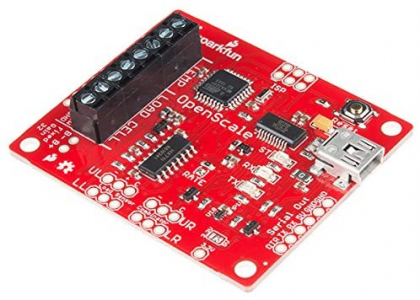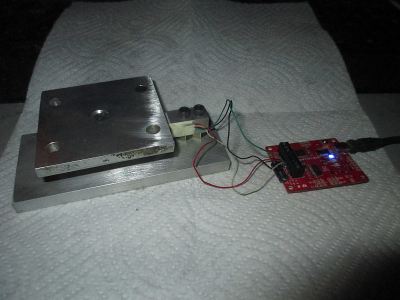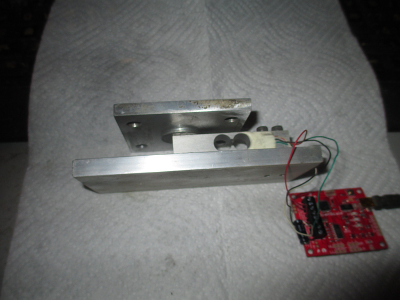- Joined
- Feb 8, 2014
- Messages
- 11,144
As I said in an earlier post, this part is really mostly a lathe job, but I wanted to do it in the mill to see what the surface finish looked like on the chamfer when finished with a ball end mill.
Here is a picture I snapped while warming up the spindle this morning. This shows how I'm holding the fixture plate in the vice. I machined a 0.125 x 0.125 step in my jaws. This is more than enough grip for this and even more aggressive operations. These are soft jaws, made of cold rolled mild steel. I just make these as I need them, and have several sets in both steel and aluminum made for various projects. I don't even own a set of hard jaws for my vises.
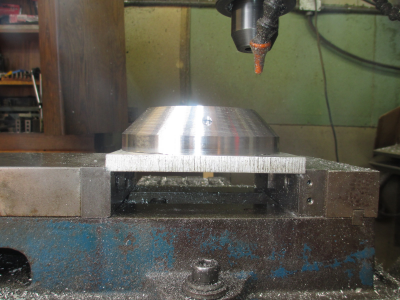
This was done with a 1/2 HSS, 4 flute, ball end mill, 300FPM (about 2000 RPM), 13 IPM, 0.020 step down and 0.020 step over, about 0.0015 tooth load. About 1 hour for the finish pass. Could have done it on my lathe in about 1 minute and had a much better surface finish. As you can see, the step down should have been a bit smaller, maybe 0.005 or so, that would have pretty much eliminated the horizontal ridges. But the biggest problem is the chatter. I couldn't hear it like normal, but I could feel the vibration in the machine. You can clearly see the chatter marks in the surface. Maybe the chatter could have been eliminated by increasing the feed speed, and using a shorter end mill, I had about 2 inches of stick out from the collet. It is also possible that conventional cutting would have better in this case rather than climb cutting because it loads the machine a bit more.
Here is the resulting finish, if I had more energy I would have played with it a bit to see if I could improve it. The finish is actually smoother to the touch than this picture would indicate and is acceptable for this application. But not what I would like.
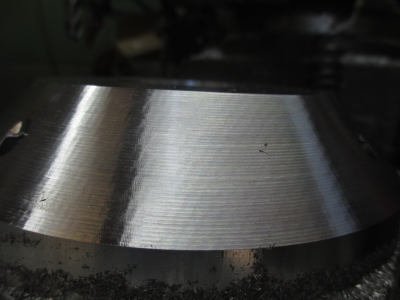
Overall it doesn't look too bad, and is acceptable.
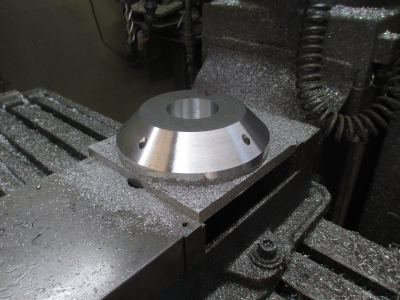
OK, I just had lunch, so that means it's nap time.
Here is a picture I snapped while warming up the spindle this morning. This shows how I'm holding the fixture plate in the vice. I machined a 0.125 x 0.125 step in my jaws. This is more than enough grip for this and even more aggressive operations. These are soft jaws, made of cold rolled mild steel. I just make these as I need them, and have several sets in both steel and aluminum made for various projects. I don't even own a set of hard jaws for my vises.

This was done with a 1/2 HSS, 4 flute, ball end mill, 300FPM (about 2000 RPM), 13 IPM, 0.020 step down and 0.020 step over, about 0.0015 tooth load. About 1 hour for the finish pass. Could have done it on my lathe in about 1 minute and had a much better surface finish. As you can see, the step down should have been a bit smaller, maybe 0.005 or so, that would have pretty much eliminated the horizontal ridges. But the biggest problem is the chatter. I couldn't hear it like normal, but I could feel the vibration in the machine. You can clearly see the chatter marks in the surface. Maybe the chatter could have been eliminated by increasing the feed speed, and using a shorter end mill, I had about 2 inches of stick out from the collet. It is also possible that conventional cutting would have better in this case rather than climb cutting because it loads the machine a bit more.
Here is the resulting finish, if I had more energy I would have played with it a bit to see if I could improve it. The finish is actually smoother to the touch than this picture would indicate and is acceptable for this application. But not what I would like.

Overall it doesn't look too bad, and is acceptable.

OK, I just had lunch, so that means it's nap time.



